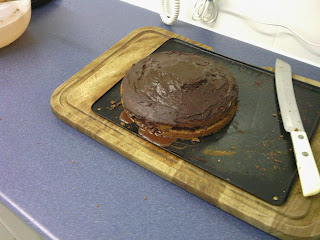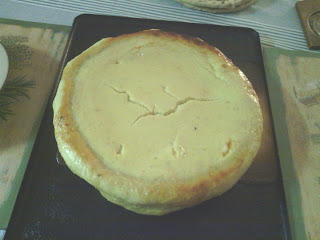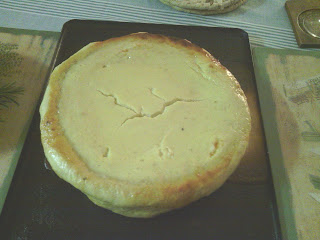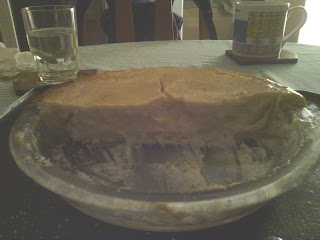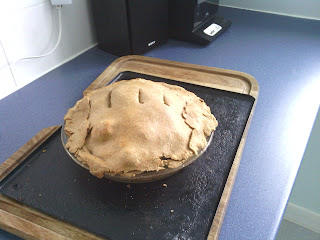At the end of February it was dad's birthday and it meant that he was another year closer to the big six-zero. It was also the time when I found out that my annual membership subscription at the Golf Club was due and that it was too late in the year to resign without paying the full fee. As a result of these two events it seemed only right to cook a bit of comfort food so I set about making a good old fashioned chocolate sponge cake.
I first put eight ounces of margarine and eight ounces of caster sugar into the mixing bowl and then creamed them together with a wooden spoon until the mixture was fluffy and there were no loose grains of sugar in the bowl.
I then took two eggs and cracked them in another bowl and whisked them together thoroughly. The eggs were then poured gradually into the bowl with the butter and sugar and mixed together. At this point the mixture looked very soft and sloppy so I took six ounces of self-raising flour plus two ounces of very dark cocoa powder and added these into the bowl a little at a time until the mixture was a lot thicker. Once there was no trace of the flour and it was totally combined into the mixture the job was done.
I meanwhile greased with margarine a 15cm wide and 3.5cm deep cake tin. I took care to add flour to the bottom of the tin to help ease the cake mixture off it after it was cooked. I then poured the mixture into the cake tin and baked it in the oven for 45 minutes on 170 degrees (180 if you don't have a fan oven).
After the mixture had cooled I turned it out onto a wire tray, took a large bread knife and sliced through the middle so as to cut the top of the cake off. I then rested cut off top on the bottom of the cake and realised it was time to make the filling. I sieved four ounces of icing sugar into a bowl and then creamed them together with an ounce of cocoa powder. I then added a tablespoon of hot water to the mixture and stirred it in until I had butter cream that was as thick as a very dense white sauce. I then spread this over the bottom half of the cake and placed the other half on top of it to form a sandwich.
In order to finish the cake off I put seventy grams of dark chocolate into a bowl that I heated over a pan of boiling water. Once the chocolate had melted I took the bowl off the hob and put an ounce of margarine into it. I then spread it over the top of the cake and left it to set.
The long process was worth it, as the cake provided the perfect comfort food bearing in mind the negative circumstances surrounding its initial creation. The fact I used dark cocoa and dark chocolate meant that it was sweet and tasty without being too sickly, which it would have been had I used milk chocolate to make it.
Saturday 31 March 2012
Sunday 18 March 2012
Blending your greens
On a Sunday afternoon last month with the late winter sun shining through into the kitchen and the sound of Cat Stevens 1970 comeback album Tea for the Tillerman with its clean, finger-picked acoustic guitar notes seeping out of the stereo I set about making soup for tea. I chose this time round to make a spinach soup.
I first took two large red potatoes, peeled them and then cut them into cubes. I next washed the dirt out of two leeks, topped and tailed them, removed their outer layers and then sliced them length ways. The pieces of leek were then cut into five parts each so as they could cook quicker and be blended without damaging the blender. The pieces of leek and potato were then placed into my trusty Le Creuset dish and fried on the hob in olive oil for ten minutes on a medium heat.
While the potato and leek were slowly frying I washed one pound of spinach and boiled up the kettle to make a pint and a half of vegetable stock using hot water and two vegetable stock cubes. After the leek and potato had fried for ten minutes I added the stock and spinach to them together with a tablespoon of freshly squeezed lemon, a teaspoon of nutmeg and a teaspoon of black pepper. I next brought the mixture to the boil and left it to simmer for about thirty-five minutes to ensure the ingredients were cooked fully and the stock and seasoning had soaked into the vegetables. You will see if you try this recipe that although there is a lot of spinach it shrinks quickly when cooked and will easily fit into the dish.
To finish off I left the mixture to cool for five minutes and then blended it and reheated it in a large pan. The soup itself is a khaki green colour when blended that isn't dissimilar to the spinach Popeye used to eat in the cartoons. To taste it is slightly bitter as a result of the lemon, nutmeg and pepper but the potato, leek and spinach give it a substance that rewards repeated helpings.
I first took two large red potatoes, peeled them and then cut them into cubes. I next washed the dirt out of two leeks, topped and tailed them, removed their outer layers and then sliced them length ways. The pieces of leek were then cut into five parts each so as they could cook quicker and be blended without damaging the blender. The pieces of leek and potato were then placed into my trusty Le Creuset dish and fried on the hob in olive oil for ten minutes on a medium heat.
While the potato and leek were slowly frying I washed one pound of spinach and boiled up the kettle to make a pint and a half of vegetable stock using hot water and two vegetable stock cubes. After the leek and potato had fried for ten minutes I added the stock and spinach to them together with a tablespoon of freshly squeezed lemon, a teaspoon of nutmeg and a teaspoon of black pepper. I next brought the mixture to the boil and left it to simmer for about thirty-five minutes to ensure the ingredients were cooked fully and the stock and seasoning had soaked into the vegetables. You will see if you try this recipe that although there is a lot of spinach it shrinks quickly when cooked and will easily fit into the dish.
To finish off I left the mixture to cool for five minutes and then blended it and reheated it in a large pan. The soup itself is a khaki green colour when blended that isn't dissimilar to the spinach Popeye used to eat in the cartoons. To taste it is slightly bitter as a result of the lemon, nutmeg and pepper but the potato, leek and spinach give it a substance that rewards repeated helpings.
Sunday 11 March 2012
Canned Gooseberry Tart
During the third weekend in February I decided to make a substantial pudding to keep my energy levels up following a late finish at work the day before and the prospect of a late night catching up with a friend I had not seen for nearly two months.
I decided to adapt a recipe for Gooseberry Tart that I had seen. I took eight ounces of plain flour and then put them in a bowl with four ounces of margarine that I had cut into small pieces about an inch long. I then worked the ingredients by rubbing them in until the mixture resembled golden breadcrumbs which were not a dissimilar shade of yellow to the colour of the moon last night and on Thursday Night. I then added two teaspoons of caster sugar to the mixture and used about three tablespoons of milk to bind the mixture together until it was in a position to roll out. Sometimes you may need a little less than three tablespoons of milk to get the ingredients to come together but you should try and make sure the pastry is quite dry bearing in mind the dampness of the filling.
The pastry when rolled out should be enough to cover a 25cm wide and 3cm deep pie dish. Always make sure that before you line the dish with pastry you have greased it thoroughly with margarine and put a little flour in it so that the pastry does not stick to it when you come to serve it.
To make the filling you first need to take a 300 gram can of Gooseberrys and purify them in a blender. It is tempting at this point to stick the purified Gooseberrys in a glass and drink them as a very sweet smoothie, instead leave them to one side and put the yolks and whites of four large eggs into a bowl with five ounces of caster sugar and eight fluid ounces of plain Greek Yogurt. You should then mix these ingredients together with a whisk before adding the Gooseberry Puree. Then the mixture should be whisked again until there are no air pockets in it which could burst whilst cooking the tart. When I cooked my tart my forearms were so sore from whisking I felt like I'd just bowled a ten over spell at my cricket team's club pro. The sore arms I have to say are worth it when you take into account the results.
I then poured the mixture into the pie dish and cooked it at 150 degrees (160 if you do not have a fan oven) for 45 minutes. I served it with a side helping of plain Greek Yogurt. The tart has a wide range of flavours; on one hand you have the sweet pastry which is balanced out by using plain Greek Yogurt in the filling. Some recipes for this tart use whipped cream instead of Yogurt, however the inclusion of the Yogurt makes the tart a little more healthy without losing the flavour and it stops the dish being too sweet and sickly for its own good.
I decided to adapt a recipe for Gooseberry Tart that I had seen. I took eight ounces of plain flour and then put them in a bowl with four ounces of margarine that I had cut into small pieces about an inch long. I then worked the ingredients by rubbing them in until the mixture resembled golden breadcrumbs which were not a dissimilar shade of yellow to the colour of the moon last night and on Thursday Night. I then added two teaspoons of caster sugar to the mixture and used about three tablespoons of milk to bind the mixture together until it was in a position to roll out. Sometimes you may need a little less than three tablespoons of milk to get the ingredients to come together but you should try and make sure the pastry is quite dry bearing in mind the dampness of the filling.
The pastry when rolled out should be enough to cover a 25cm wide and 3cm deep pie dish. Always make sure that before you line the dish with pastry you have greased it thoroughly with margarine and put a little flour in it so that the pastry does not stick to it when you come to serve it.
To make the filling you first need to take a 300 gram can of Gooseberrys and purify them in a blender. It is tempting at this point to stick the purified Gooseberrys in a glass and drink them as a very sweet smoothie, instead leave them to one side and put the yolks and whites of four large eggs into a bowl with five ounces of caster sugar and eight fluid ounces of plain Greek Yogurt. You should then mix these ingredients together with a whisk before adding the Gooseberry Puree. Then the mixture should be whisked again until there are no air pockets in it which could burst whilst cooking the tart. When I cooked my tart my forearms were so sore from whisking I felt like I'd just bowled a ten over spell at my cricket team's club pro. The sore arms I have to say are worth it when you take into account the results.
I then poured the mixture into the pie dish and cooked it at 150 degrees (160 if you do not have a fan oven) for 45 minutes. I served it with a side helping of plain Greek Yogurt. The tart has a wide range of flavours; on one hand you have the sweet pastry which is balanced out by using plain Greek Yogurt in the filling. Some recipes for this tart use whipped cream instead of Yogurt, however the inclusion of the Yogurt makes the tart a little more healthy without losing the flavour and it stops the dish being too sweet and sickly for its own good.
Sunday 4 March 2012
Complicated pie yields tasty results
A few Sundays ago instead of having my normal morning dog walk I had a bit of a lie in (a rarity for me these days) as it was raining heavily. When I finally became motivated to get up I decided to cook a pie for Sunday Dinner; my choice was a pie that is not the easiest to make but if prepared correctly makes a top quality meal.
With the Led Zeppelinesqe heavy rock riffs of Rush's second album Fly by Night playing through the stereo in the kitchen I first laid my hands on two heads of Fennel, a medium-sized cauliflower and a small red onion. I washed the vegetables thoroughly and then cut them up into relatively small pieces. I next put them into a steamer and left them to steam until soft for about twenty minutes.
In the meantime I prepared my pastry. I find that wholemeal pastry is the best type to use for this recipe to stop it becoming too bland for its own good. I measured out eight ounces of wholemeal flour, not wholemeal bread flour I might add, if you use wholemeal bread flour it makes it difficult to bind the ingredients together to make good pastry. I poured the flour into a mixing bowl and added four ounces of margarine to the flour. I then rubbed the ingredients together until they resembled breadcrumbs. I next poured into the bowl about two tablespoons of unsweetened soya milk and mixed it with the other ingredients. I then rubbed the ingredients together until they formed a ball of pastry. Sometimes when making this type of pastry you may need a little more soya milk than I have stated but if your pastry becomes too sticky as a result be prepared to add more flour to dry it up so you can roll it out properly.
I then put the pastry to one side for a time while I tested the steamed vegetables with a fork to ensure they were soft and therefore ready. I then turned off the heat and left them to stand. I next made a white sauce by first melting in a pan on a low light an ounce of margarine and then combining it with a heaped tablespoon of plain flour and a pinch of mustard and white pepper. I then gradually added some skimmed milk while keeping the pan on the heated hob. I continued to add in a bit of milk at a time and mix the ingredients together until I was left with a white sauce that was thicker than cheese spread. It is key for this recipe that the white sauce is as thick as possible. Once the sauce is thickened I left it on a very low heat on the hob.
The next part of the preparation was thankfully a little easier as I all I needed to do was add a quarter of a pint of boiling water to a stock cube in a measuring jug to prepare the vegetable stock. A quarter of a pint of stock is about right for this recipe as any more than this will make the pie soggier than a wet weekend in Reigate.
I now rolled out my wholemeal pastry as flat and as thinly as possible without it becoming wafer thin. I used two thirds of it to line the bottom of a pie dish about two centimetres deep and about 20-25cm across. I next piled the vegetables into the dish (in the way shown in the first picture) and poured in the vegetable stock. In order to finish off the filling I placed the white sauce on top of the vegetables and spread it over them like thick butter with my wooden spoon. I then covered the pie with the remaining pastry and pressed down the edges at the side of the pie so as to seal it totally. In order to let the heat out when cooking I cut three two centimetre long slits in the top of the pie and brushed the pastry with semi-skimmed milk. In order to make the pie oven ready I greased some foil and put it over the top of the pie so as the whole top was covered.
I was near the finish line with this recipe when I put it in my oven which I had pre-heated to 190 degrees (200 degrees if it wasn't a fanned oven). I cooked the pie with the foil on it for 30 minutes, took it out of the oven, removed the foil and then cooked it for a further ten minutes.
The complicated procedure was worth the wait as you can see from the pictures that the mix of vegetables, white sauce and stock together with the wholemeal pastry make for a pie which has all the substance of a meat pie. I chose to serve mine with boiled peas (steamed broccoli will do if you dislike peas) and plenty of brown sauce which enhances the taste even more.
Subscribe to:
Posts (Atom)
